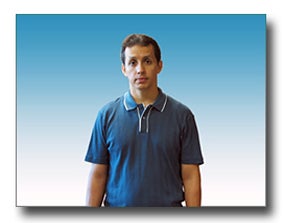Look at the camera, not the screen
- Looking directly at the video camera is the only way to maintain direct eye contact with your audience.
AppearanceSetup and On-Camera Presence
- Position your camera at eye level, at about 2-4 feet from you to provide good framing. Position yourself in the middle of the frame, allowing space between the top of your head and the top of the frame, avoiding angles where the camera lens is looking up or down on you.
- Look directly at the camera.
- Position yourself so the windows are facing you and avoid overhead lighting. Make sure the light source is in front of you, not behind you, so you don’t get accidentally silhouetted. If you need additional light, place a lamp in front of your face.
- Keep your hand movements/gestures to a minimum.
- Lighter colors will always work best. Avoid tight patterns if possible.Not all physical cues translate from in-person to remote environment, which make the ones that do even more important. Avoid clothes that are really dark and that have patterns, they do not show well on camera. Avoid accessories that make noise.
- Be sure to have good posture and relax your shoulders to avoid stiffness.
Prepare your surroundings
- , avoid seats with wheels/swivels, overstuffed cushions, or are squeaky.
- Don’t join a meeting/webinar in noisy areas. Pick a quiet place without an elaborate backdrop so that you can be the focal point on the screen.
- Remove anything distracting behind you. Tidy up the your space and make sure it is not cluttered or messy.
- Try to have light on your face whenever possible, and avoid sitting in front of bright window or monitor.
- Be sure to give the camera on your device a quick wipe with a soft cloth.
- Use a virtual background.
Practice Technical
- Do a run-through prior to your meeting/webinar. Go over the agenda, tech, and features of the platform you are using, i.e. chat, Q&A functions, etc.
- Check the lighting and background of where you’ll be sitting and check the audio and camera settings. If you need additional light, place a lamp in front of your face.
Technical
- Don’t use an unstable internet connection. Good bandwidth is important. While a strong wireless signal works, if possible use a wired Ethernet connection to the internet. Upload speeds between 5-8Mbps are recommended for HD and Full HD video. Use speedtest.syr.edu to ensure you your internet connection is good.
- Be sure you have the latest version of the platform you are using.
- Double-check meeting settings.
- Test audio/video as you join.
- If possible, use a USB headset.
- Avoid using the browser to join, you may not have all the functionalities of the platform you are using.
- Close other programs on your computer. Before your meeting/webinar, make sure all other windows on your computer are closed (especially if they make noise). Having other apps/pages running can also affect connectivity and latency.

